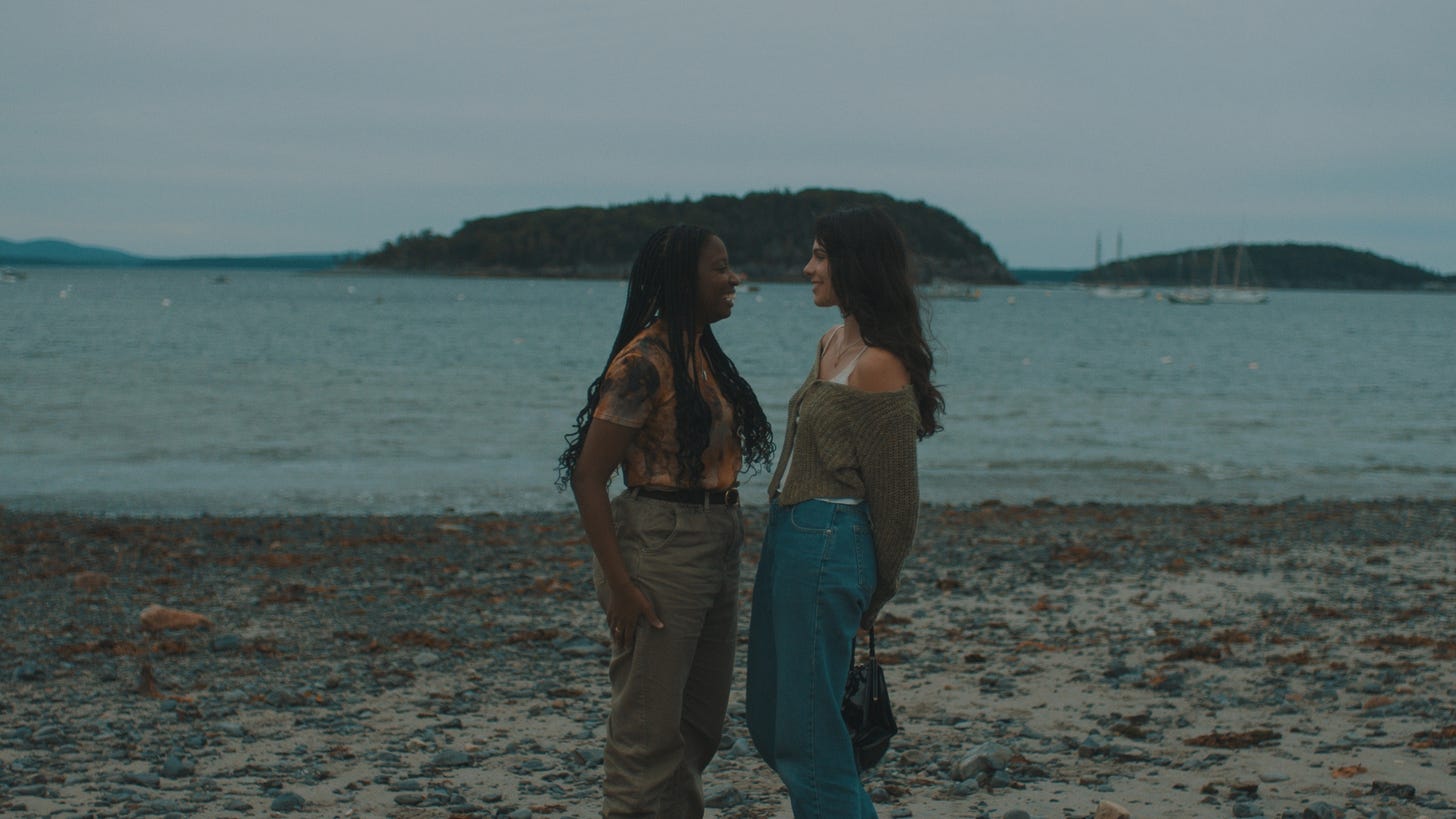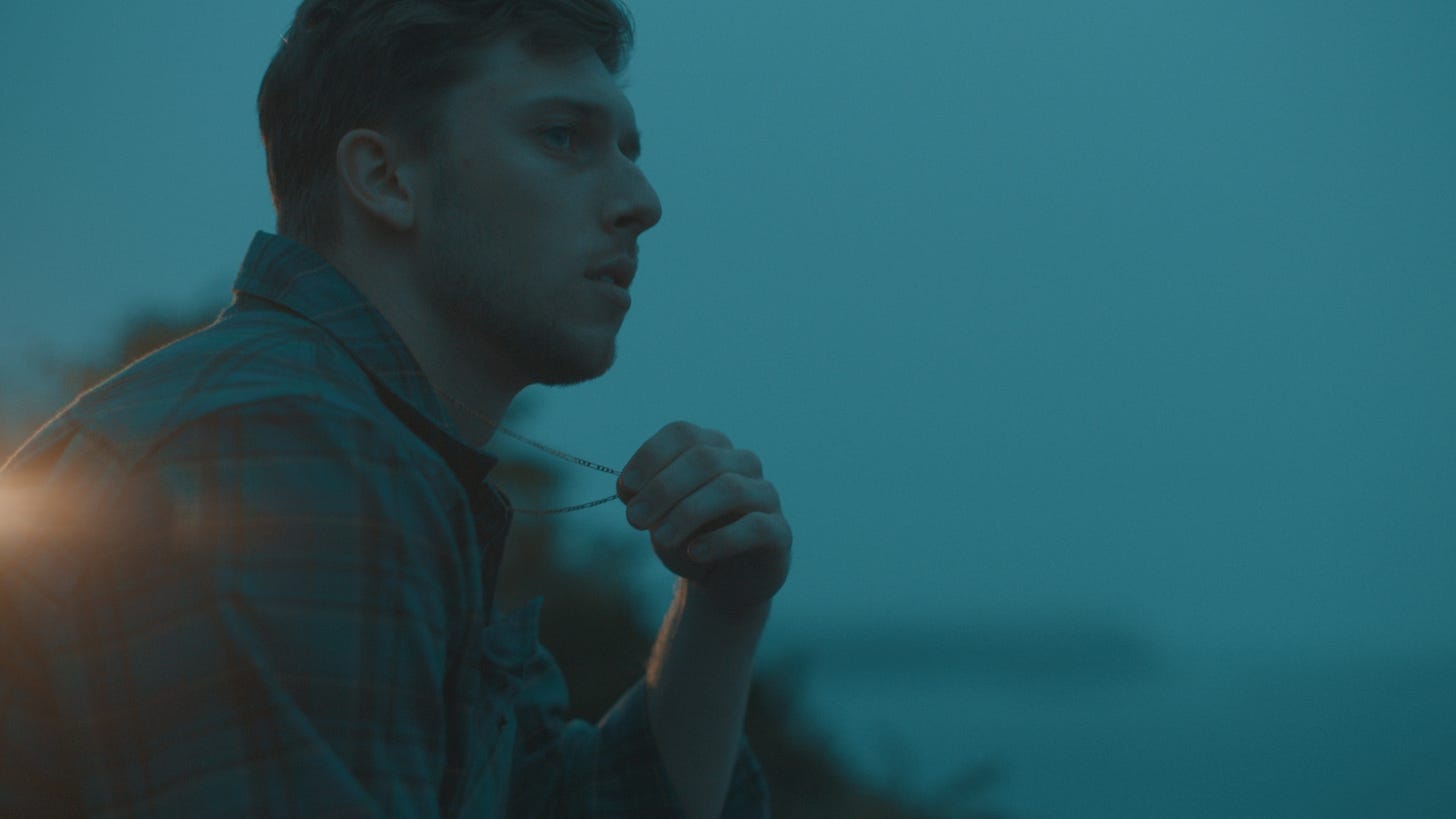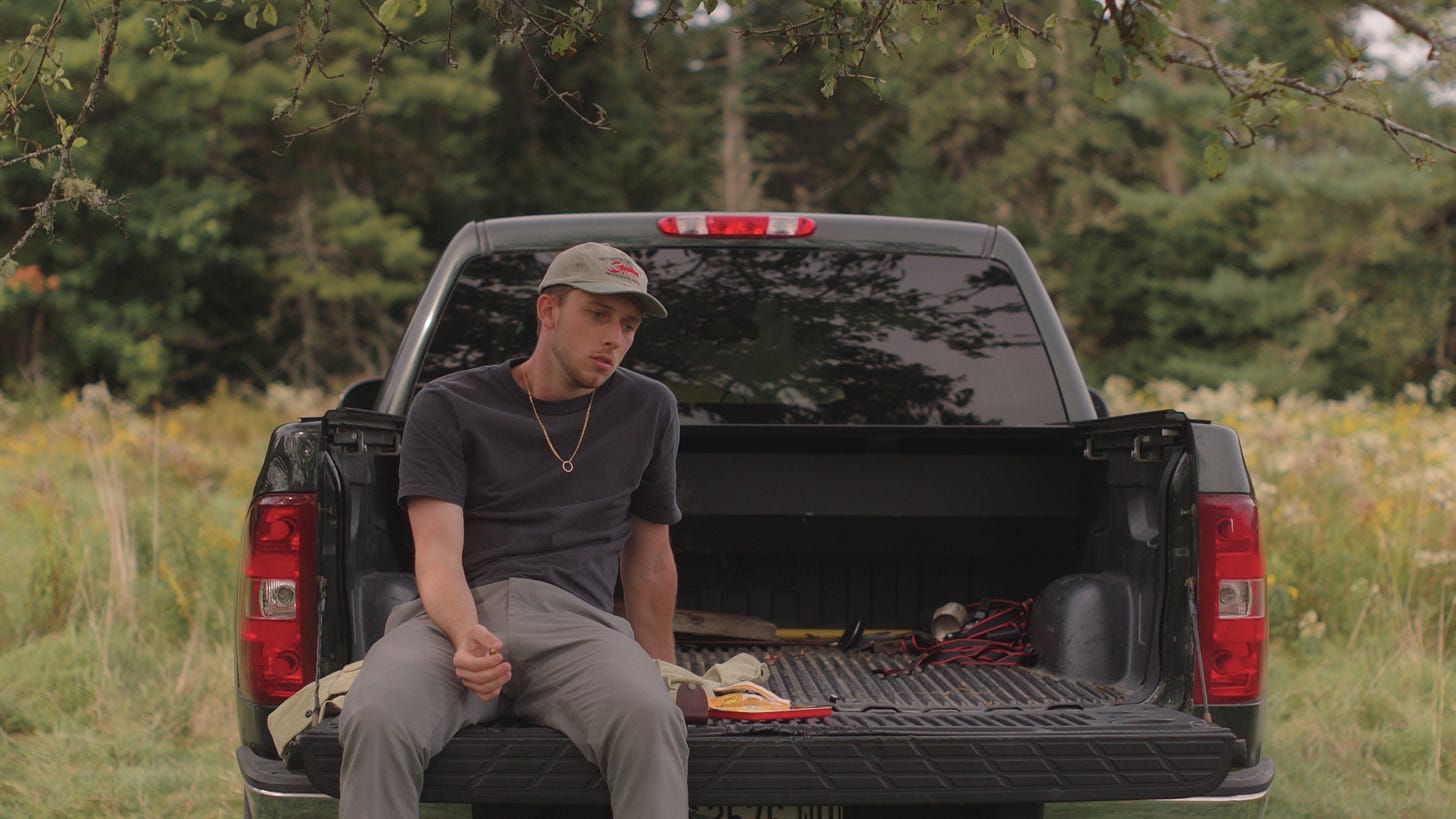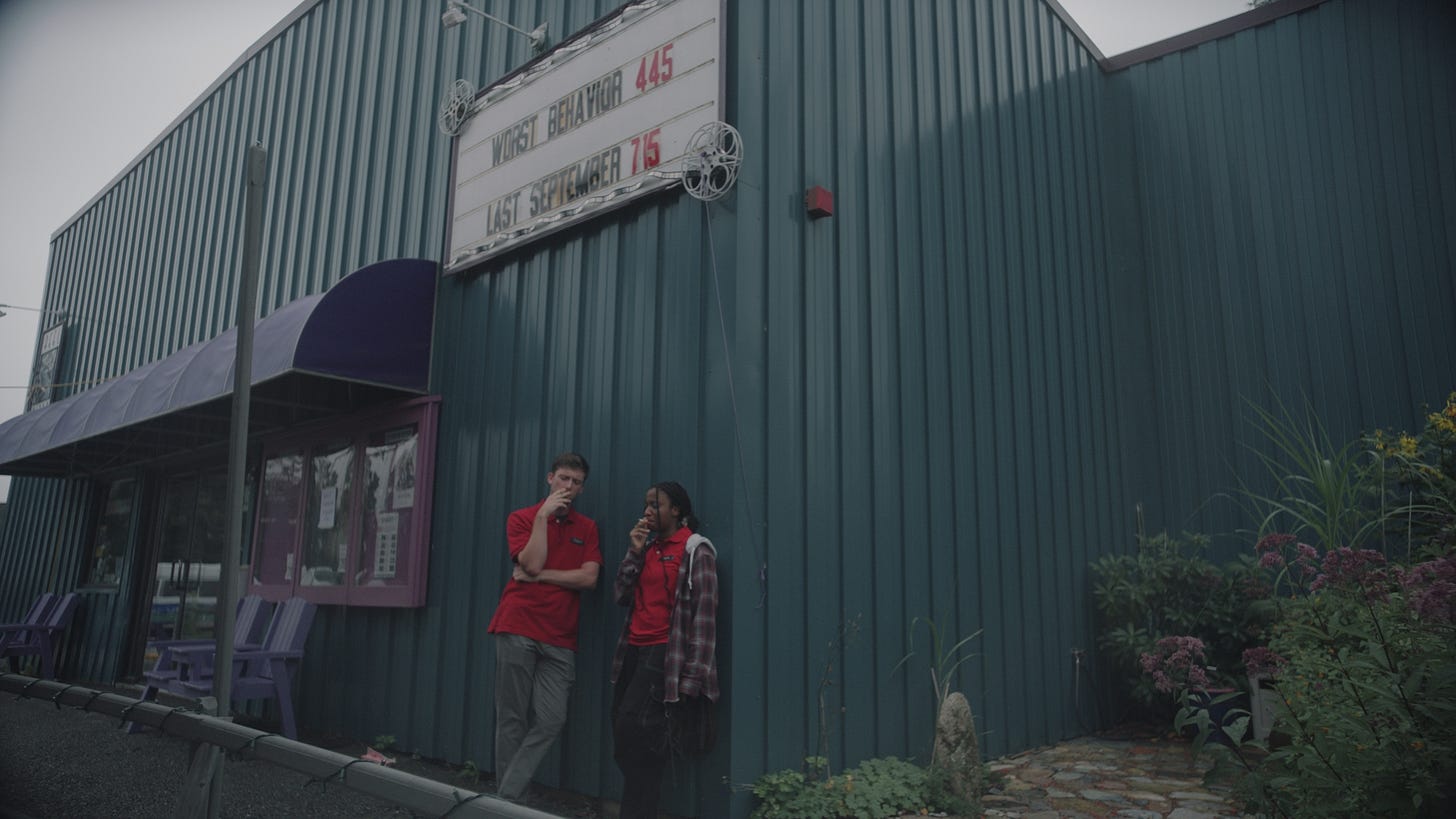From Hinge to Film Shot on MDI, Two Gen Z Creators Focus on Raw and Human Storytelling
And they need your help
The Bar Harbor Story is generously sponsored by Side Street Cafe.
BAR HARBOR AND LAMOINE—An interaction on the dating app Hinge has led to not just a relationship, but also a collaboration that involves Mount Desert Island, films, and the creation of story for two twenty-somethings with a connection to Hancock County.
Carla Troconis and Jack Revkin met on Hinge, quickly debated a movie, dated, and started a journey together that including shooting a film, “Worst Behavior,” in Bar Harbor, Winter Harbor, and Lamoine, which is where the couple spend part of their time when they aren’t in Brooklyn.
Now, the duo hopes to crowd-source the final costs of editing, sound, music, and festival entries. The deadline is January 26 to cover those post-production needs.
The duo shot the indie short film about identity tussles for people in their twenties all around Bar Harbor in summer 2023 as Hurricane Lee approached. Reel Pizza was the site of the opening scene. Other scenes were shot in a local quarry, Winter Harbor, and more. The pair has worked on the film in between their freelance film work. Carla also directed a play at the Fringe Festival in Edinburgh last summer.
The goal is to have the film ready for festival submissions by February 1, 2025. The anticipated release is early summer 2025.
The pair also shot a sixty-second documentary off MDI in the summer of 2024. That focuses on Emma Fernald. Fernald is the seventh-generation lobster fisher in her family and has created the company, Bay Lady Scallops.
WORST BEHAVIOR
The film focuses on Julie who longs for a new start and leaves New York for Maine to connect with Noa, her lost love.
“As she begins to work at a local theater, she befriends a local, Trent,” according to the fundraising site. “This newfound friendship with her coworker soon complicates things after he encourages Julie to take his recently-become-ex-girlfriend, Erin, on a date, unknowingly disrupting the delicate balance of their friendship while jeopardizing Julie's rekindling romance with Noa.”
As the narrative progresses, the characters’ emotions and loyalties grow and stakes raise.
On the fundraising page, the couple writes, “We hope that ‘Worst Behavior’ serves as a candid and emotional representation of what can happen when we let social media, selfishness, and the ‘always- something - better’ philosophy take over our personal relationships. If this film can serve as a mirror during this time of deep loneliness and loss for our generation, maybe it can also prompt us to treat each other with more much needed humanity.”
As of January 15, they’d raised approximately $5,500, which is 55% of their $10,000 goal. They have 11 days left to reach that $10,000 mark. To help encourage donations, and as a way to say thank you, they offer benefits at each pledge level.
THE INTERVIEW
We were lucky enough to be able to ask Carla and Jack some questions and they graciously answered so well that we didn’t want to take their thoughts apart and redistribute them into story. Our questions are in bold. Carla and Jack’s answers are in regular print and labelled with their names to indicate who is responding.
First off, how did you two meet and how did you decide to make films together?
CARLA—We met on Hinge! We actually became quickly embroiled in a debate over a recently released movie and from there, knew we had to go on a date.
We decided to make films together because, at the time, Jack had a script (“Worst Behavior”) that he was refining. Pretty early on, he asked me to read it over and give some notes. That started us on the path of collaboration and pretty quickly, Jack asked me to produce the movie.
Since then, our mutual love of film and copacetic methods of collaborating have pushed us to continue working together. Jack and I have very different strengths in filmmaking and for that reason, I think we push each other to grow and improve as professionals and as individuals. Plus, working together on the film was kind of the ultimate test for our relationship. It helped us establish a deeper sense of trust and learn how to help each other when things are really stressful.
Can you tell me a little about WORST BEHAVIOR? About Situationships?
JACK—“Worst Behavior” is a short film Carla and I shot in September of 2023 in and around Bar Harbor and the Lamoine area. The story follows Julie, a New York native who moves up to the area after reconnecting with an ex of hers, Noa. While in Maine for the summer, Julie is thrust into a mix of romantic entanglements and messy relationships/situationships because of her coworker, Trent. The two of them work together at Reel Pizza, a local favorite, and a dominant location throughout the movie.
We use the term situationship a lot when describing the film. The phrase is new and something predominately heard amongst Gen Z circles. A situationship is a relationship defined by a situation rather than a relation. Noncommittal and undefined, it has become a commonplace form of relationship amongst a lot of this generation.
Friendships, relationships and communication are themes in there, right? And also that leaning toward being uncommunicative?
JACK—We really wanted to highlight a dilemma of our time: the illusory connectivity of social media and the internet writ large. Despite all the continued advances in tech that want to connect us as a species, we can’t help but be uncommunicative with each other. Many people are lonelier than ever before despite all these instantaneous communication networks. “Worst Behavior” was really born from this idea. The film explores these themes of miscommunication and how it can greatly affect people.
How important was it for you to have your production team be full of people who are Generation Z? And for representation within that?
CARLA—This was really important for us for a couple of reasons. First, we’re both young people in the industry and it’s always harder for people in our generation to be on crew, especially as department heads. It was exciting for us to be able to offer talented young people the opportunity to not only work on a film as relevant to their lives as this one, but to really help steer and mold the creative. In addition, we were excited to have a crew that was made up of many women, especially in production and camera departments: two departments that are often very male. And finally, since the story does center a queer narrative, it was important for us to have a crew made up of many members of the LGBTQ+ community.
On your Seed&Spark page, you write, “If this film can serve as a mirror during this time of deep loneliness and loss for our generation, maybe it can also prompt us to treat each other with more much needed humanity.”
Can you speak a tiny bit to why you think that this is a time of deep loneliness and loss?
And why telling stories that promote humanity is so important to both of you, your generation, and beyond?
JACK—The world has entered a turning point recently with the advent of Artificial Intelligence. It has thrown our whole world for a loop, much in the same way that the internet did in the late 90s. So much of what once looked like a distant future now seems to be accelerating towards us at a rapid pace; this brings so much uncertainty to our generation as well as generation Alpha, and the brand new generation Beta.
Much of what used to be art has now been commodified and coined under the term “content” which allows for AI to come in and replace artists and creators with artificially generated paintings, movies, literature, even worlds. It is so crucial now, more than ever, to push raw and human storytelling that can connect with the deeper response of the soul that art brings forth within us.
You all describe WORST BEHAVIOR as a labor of love? Can you tell me a bit more about that?
CARLA—Absolutely. We are so lucky to have had the kind of crew, cast, and support systems that could make this movie happen, especially at the micro budget level it was filmed at.
Besides working with a very tight budget, we had a couple of unforeseen accidents / circumstances that made filming this movie that much more difficult. The weather was quite unmanageable during our shooting week, meaning we often had to pause or even reschedule filming completely because of horrible rains; Hurricane Lee came right as we wrapped shooting.
We had multiple vehicles break down that week, which stalled our schedule and made transporting our cast and crew that much harder.
And finally, all of our crew worked on this film for rates that were well below what they usually take.
We’re so grateful that people put their time and energy into this movie, even amidst all of the difficulties that came from these unlucky freak occurrences. So we really consider this, on our parts and on the part of the entire cast and crew, as a labor of love.
Do you have any specific stories of hurdles and/or joys that happened during its filming and production?
CARLA—We had a lot of happy accidents that came from these weird setbacks. One in particular that stands out is that we were originally planning on shooting a scene at this great take out place in Hancock, Maine – Yu Takeout.
While we were shooting there, we were hit with a torrential and completely unpredictable downpour that made it practically impossible to capture the scene.
Because of this, we ended up having to reschedule that scene for another day and sadly, find a new location as Yu Takeout was closed during our other potential filming hours. Jack ended up suggesting we film the scene at Grindstone Point, and it was some of the most beautifully shot footage we have. It was an even better, more fitting location for the scene, and we liked the footage so much that a shot from said location has become one of our key images in promoting the film.
And can you tell me how big your team was?
During production, our crew was 15 and our cast was four. We have a total crew of 16 (includes our editor in post).
I love how your sound design and cinematography really loops into each other so well. I’m not sure if I have a specific question about that, but there’s something so compelling that hooks you forward as the sound and image play with each other.
CARLA—Thank you so much! This was always important to us and to Jack’s vision so we’re happy to hear we’ve achieved that :)
JACK—Our editor Setareh has worked their butt off for this project and has added so much. They really bring a lot to the final edit which is so important to us. Another major reason for our fundraising efforts is to raise enough to pay them and our composer a well rounded rate for all their hard work.
Do you all split your time between Brooklyn and Lamoine? Is that hard or energizing? Or both? Do you think that it influences your art?
JACK—Yes, we do split our time between Brooklyn and Lamoine. The two places are diametrically opposed in a lot of ways. Lamoine is quiet, tranquil and time moves a lot slower there; in Brooklyn, there’s a lot of kinetic energy. Time moves much faster. We’ve found that slowing down in late summer– August and September– is perfect, while speeding up in the fall and spring keeps us on top of work schedules that we want to keep active.
I think this definitely influences our art because it gives us more time to be considerate and develop ideas and work that we may have rushed through while in the city.
You also created a sixty-second documentary on Emma Fernald this summer. Can you tell me about that project, what inspired you, how you feel about it. And are you expanding it?
CARLA—Totally! I often work with an agency called Adolescent Content and they often do “micro-grants” for filmmakers. In August, they announced they were accepting applications for a microgrant for 60-second documentaries. I had just returned from the Fringe Festival in Edinburgh to Lamoine and thought it would be cool to do a piece about something local and pertinent to life in coastal Maine.
Jack and I brainstormed and landed on wanting to shoot a small doc centered around a lobster fisherman. Then one day, when we were out to eat at Flex-It in Downtown Ellsworth, Jack stumbled upon a profile of Emma Fernald in the local newspaper. We both thought her work sounded so cool and were excited about focusing the documentary on someone who was a younger person in the lobstering industry.
Jack and I got in contact with Emma and spent a day with her, her father’s second man, and her father on his lobster boat. Jack shot most of the footage and I manned the mini DV camera that captured extra footage. Then, the next day, we spent time with Emma on her boat while she was tending to her scallop farm. We also interviewed her.
I feel really great about the piece! I spent a lot of time editing it and really fine tuning it so it could be, more than anything, a poetic, character portrait. I feel as if I achieved that efficiently in the 60 seconds I had.
We are planning on expanding the documentary into a longer (still short) cut. We have a lot of footage from Emma’s interview still that provides more detail on some of the issues she touched on. I’d like, ideally, to make a 6-7 minute cut that still has the same vibe but dives a little deeper into her story and the state of the industry in Maine.
You just launched a crowd-sourcing fundraiser. Would you mind talking a bit about that? And about the expense and difficulties of financing creativity?
CARLA—We did just launch our crowdfunding campaign on Seed & Spark. It is active until January 26 and we’re really excited to report that to this date, we’ve already raised about $5,500 of our $10,000 goal.
Making movies is hard and it is expensive. Although they might seem simple, every movie has a dedicated team of professionals working nonstop to make sure it’s crafted with care. In addition to this, equipment, editing software, festival fees, catering, and transportation all costs money. We’re very lucky that our initial production was generously funded by family and Jack himself. However, we’re doing this final push for post-production so we can pay our editor, composer, post-production sound mixing + mastering team, festival and screening fees, and some leftover rollover costs from production that Jack and I have personally covered to date.
It is, no doubt, difficult to finance creativity and moviemaking, especially in the current climate. Studios and large fundraising partners are more conservative and hard to reach than ever; less and less people are taking risks on independent films from emerging creators. However, we’ve already seen such an outpouring of care and support from family, friends, and the local community. It warms our heart that “Worst Behavior” has such a family of supporters. We’re hoping we can secure the remainder of the funds needed to reach our goal and be able to finish up this film so we can finally share it with that family and the world at large!
I heard that you might have a screening at Reel Pizza this summer? Is that a go?
CARLA—We haven’t locked this into place yet. but it is a goal of ours! We were able to film at Reel Pizza for some scenes in the movie (thank you so much, Lisa) so it would be amazing to be able to host a screening there once the film is done.
ABOUT JACK AND CARLA (via the Seed & Spark)
Jack Revkin - Writer / Director
“Jack is screenwriter and filmmaker based in New York City. Originally from the Hudson Valley, Jack studied film and television at Boston University where he developed a few projects, some documentary, some narrative. Here, he developed a passion for storytelling that highlights small, local communities and unconventional scenarios. After working at the Cannes Film Festival in summer of 2021 and seeing Ryusuke Hamaguchi’s Drive My Car, he realized how these types of unconventional love letters to a place, person, or moment of time can so powerfully connect us to the world around us and help us understand our experiences more completely. Worst Behavior has been a passion project years in the making, going through multiple phases and various lives, and he is very excited to finally bring it to audiences.”
Carla Troconis - Producer
“Carla is a Venezuelan-American producer, director, and writer. After graduating from Harvard (2019), she cut her teeth in the media business (Zuckerberg Media COS) before leaving to produce and direct freelance. Carla has worked as a director and producer with musical artists like Marcus Mumford and Quarters of Change; commercial partners like Rag & Bone and Biden / Harris 2020; and with agencies like Adolescent Content, A-B Partners, and Suitcase. She has produced and directed short films that have been accepted to such festivals as the Los Angeles Latinx Film Festival, the New York City Independent Film Festival, and the Latino Film Market. As a theatrical director and producer, Carla has participated in programs like 24H Play Nationals and exhibited work at The Tank, Theater Row, WP Theater, and Zoo Southside as part of the Edinburgh Fringe Festival (2024).”
Note: All images are either stills from the movie or from the fundraising page.
Carla and Jack note, “If you've already donated to this crowdfunder or don't feel able to, please help us out by spreading the word on your social media, email lists, and personal networks!
You can share the link to this Seed & Spark.
LINKS TO LEARN SO MUCH MORE
To help Carla and Jack get to their goal, click here.
To find out more about their project, head here.
An instagram post by Hannah Freeman showing the production team in Maine.
If you’d like to donate to help support us, you can, but no pressure! Just click here (about how you can give) or here (a direct link), which is the same as the button below. Our mailing address is 98 Ledgelawn Ave., Bar Harbor, Maine, 04609
If you’d like to sponsor the Bar Harbor Story, you can! Learn more here.















